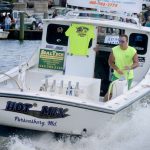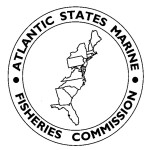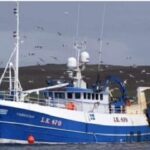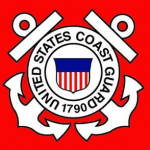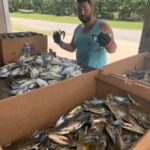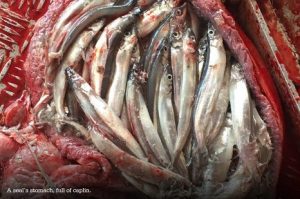Daily Archives: October 19, 2016
The U.S. Labor Department suing Intershell over workers’ wages
 The suit, filed Oct. 4 in U.S. District Court in Boston, seeks at least $275,000 from Intershell for back wages and liquidated damages. The Labor Department said Ultimate Advance Corp., which provides Intershell with temporary workers, is jointly liable for about $116,000 of the total amount being sought. The federal department said an investigation by its wage and hour division revealed that Intershell owners Monte Rome and his wife Yibing Gao-Rome, in conjunction with Ultimate Advance, violated federal law by not paying overtime to 55 workers responsible for cutting, cleaning and packing seafood.It said Intershell had been involved in the violations since February 2013 and Ultimate Advance since 2015. The suit also charges the defendants failed to keep accurate records of employees’ work hours and provided inaccurate payroll records to the division’s investigators. It accused them of “improperly deducting from certain employees’ pay the cost of cleaning their uniforms.” Read the rest here 19:58
The suit, filed Oct. 4 in U.S. District Court in Boston, seeks at least $275,000 from Intershell for back wages and liquidated damages. The Labor Department said Ultimate Advance Corp., which provides Intershell with temporary workers, is jointly liable for about $116,000 of the total amount being sought. The federal department said an investigation by its wage and hour division revealed that Intershell owners Monte Rome and his wife Yibing Gao-Rome, in conjunction with Ultimate Advance, violated federal law by not paying overtime to 55 workers responsible for cutting, cleaning and packing seafood.It said Intershell had been involved in the violations since February 2013 and Ultimate Advance since 2015. The suit also charges the defendants failed to keep accurate records of employees’ work hours and provided inaccurate payroll records to the division’s investigators. It accused them of “improperly deducting from certain employees’ pay the cost of cleaning their uniforms.” Read the rest here 19:58
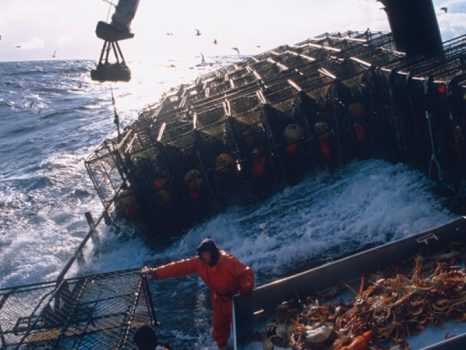
Members of Alaska crab industry are holding out hope for high prices and a late fishery.
The Alaska Board of Fisheries hasn’t yet decided whether to review harvest guidelines for Eastern Bering Sea Tanner crab and potentially open the season in January or earlier, or leave the fishery closed entirely for the next two years. Meanwhile, the Alaska Department of Fish and Game cut the quota for snow crab by 50 percent and for Bristol Bay red king crab by 15 percent. Despite the cuts, crab industry stakeholders say the season for Bristol Bay red king crab is moving along at more than a healthy clip. “Some good news from the grounds, the crab look good. They’re heavy. There’s a lot of small crab, females. Folks are seeing pots just plugged with crab — so full they can’t get another one in,” said Jake Jacobsen, director of the Inter-Cooperative Exchange, a crab harvesting cooperative with 188 members that together harvest 70 percent of Alaska’s crab. Jacobsen said that given the density of the fishing, he wonders why the surveys that measure abundance didn’t pick anything up.“The reports I’ve got, maybe the people who aren’t doing so well don’t say anything,” he said. “There’s a lot of very optimistic reports from the grounds. I’m not sure what happened with the survey last summer.” Read the story here 16:53
Fishermen upset over extension of ban
 With only six months remaining in a two-year ban on all fishing activities in the vicinity of the port town of San Felipe, Baja California, there is now disagreement between fishermen and environmental groups over what happens next. Fishing techniques had become a threat to the vaquita, whose numbers have declined to an estimated 60, because they are caught along with the totoaba, a fish species whose swim bladder is a delicacy in China. The two-year federal program was intended to give the marine mammals a respite started in April 2015. As its end draws near, environmental organizations have asked authorities for broader controls on the illegal totoaba fishing and the creation of a safe zone for the vaquita. Read the story here 14:59
With only six months remaining in a two-year ban on all fishing activities in the vicinity of the port town of San Felipe, Baja California, there is now disagreement between fishermen and environmental groups over what happens next. Fishing techniques had become a threat to the vaquita, whose numbers have declined to an estimated 60, because they are caught along with the totoaba, a fish species whose swim bladder is a delicacy in China. The two-year federal program was intended to give the marine mammals a respite started in April 2015. As its end draws near, environmental organizations have asked authorities for broader controls on the illegal totoaba fishing and the creation of a safe zone for the vaquita. Read the story here 14:59

Coast Guard transports pregnant manatee to Florida following rescue in Massachusetts
The Coast Guard teamed up with multiple animal rescue teams to transport a pregnant manatee Tuesday from Mystic Aquarium in Connecticut, to SeaWorld in Orlando, Florida. Expert rescue staff from the International Fund for Animal Welfare (IFAW) rescued the manatee September 22 from the waters off Falmouth and transported her to Mystic Aquarium. The manatee arrived in Florida aboard a Coast Guard Air Station Cape Cod HC-144 aircraft. Upon arrival, she was transported to SeaWorld by their Animal Rescue Team where veterinarians will provide round-the-clock care until she is ready to be released to her natural Florida habitat. “It was a pleasure working with the U.S. Fish and Wild Life Service, Mystic Aquarum, IFAW, and SeaWorld to transport the manatee to SeaWorld in order for her to be released to her natural habitat,” said Lt. Daniel Cloonan, one of the pilots from Air Station Cape Cod who flew the manatee to Florida. “It was a unique mission where all the moving parts and joint collaboration came together tremendously.” The manatee was named Washburn after the island she was rescued on. Link 14:39
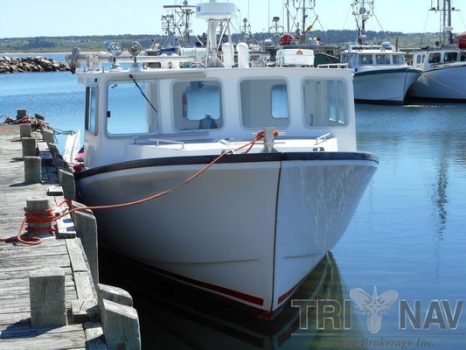
Athearn Marine Agency Boat of the Week: 42′ Fiberglass Lobster boat, 500HP, 6 Cylinder Volvo D9 Diesel, “like new” condition!
Specifications, information and 14 photo’s click here To see all the boats in this series, Click here 12:31
Oceana bites back at proposed rule for US dusky shark conservation
 U.S. President Barack Obama and his administration have released a proposal addressing the chronic overfishing of dusky sharks in U.S. waters. But suggested rule comes up short on its objective, according to marine conservation group Oceana. Oceana, which sued the federal government in 2015 in a challenge to its policies on dusky sharks, has deemed the proposed rule as “grossly inadequate,” and charged that that the National Marine Fisheries Service fails to offer measurable means to stop dusky shark decline and facilitate the species’ recovery. Over the past two decades, dusky shark populations across the Atlantic and Gulf coasts have dropped by 65 percent as a result of bycatch and overfishing, said Oceana. Because the species is slow to grow and reproduces at low rates, recent studies suggest that the population would need between 70 and 180 years to recover. Read the story here 12:06
U.S. President Barack Obama and his administration have released a proposal addressing the chronic overfishing of dusky sharks in U.S. waters. But suggested rule comes up short on its objective, according to marine conservation group Oceana. Oceana, which sued the federal government in 2015 in a challenge to its policies on dusky sharks, has deemed the proposed rule as “grossly inadequate,” and charged that that the National Marine Fisheries Service fails to offer measurable means to stop dusky shark decline and facilitate the species’ recovery. Over the past two decades, dusky shark populations across the Atlantic and Gulf coasts have dropped by 65 percent as a result of bycatch and overfishing, said Oceana. Because the species is slow to grow and reproduces at low rates, recent studies suggest that the population would need between 70 and 180 years to recover. Read the story here 12:06
Opinion: Stop the Obama administration from destroying our coastal economy
 The Obama Administration is very close to unleashing an underwater sonic boom attack off our Atlantic Coast, including South Carolina’s. You probably have two immediate questions. What am I talking about? And why should you care? First, a sonic boom is how Richard Viso, a professor in the Coastal Environment School at Coastal Carolina University, describes seismic testing. Seismic testing is a highly dangerous process that uses intense airgun blasting to send extremely loud sound waves miles below the seafloor in a hunt for oil deposits. One seismic testing vessel can tow up to 96 airguns, which can cover an area 21 times larger than the National Mall in Washington. These sonic booms, which can be heard for thousands of miles underwater, are repeated every 10 to 12 seconds, creating one of the loudest noises in the oceans. Seismic testing under just one lease can go on for up to an entire year. The Obama Administration’s Department of Interior is set to issue up to 9 seismic testing permits because oil companies don’t share information. Read the story here 11:37
The Obama Administration is very close to unleashing an underwater sonic boom attack off our Atlantic Coast, including South Carolina’s. You probably have two immediate questions. What am I talking about? And why should you care? First, a sonic boom is how Richard Viso, a professor in the Coastal Environment School at Coastal Carolina University, describes seismic testing. Seismic testing is a highly dangerous process that uses intense airgun blasting to send extremely loud sound waves miles below the seafloor in a hunt for oil deposits. One seismic testing vessel can tow up to 96 airguns, which can cover an area 21 times larger than the National Mall in Washington. These sonic booms, which can be heard for thousands of miles underwater, are repeated every 10 to 12 seconds, creating one of the loudest noises in the oceans. Seismic testing under just one lease can go on for up to an entire year. The Obama Administration’s Department of Interior is set to issue up to 9 seismic testing permits because oil companies don’t share information. Read the story here 11:37
Public weighs in at Board of Fisheries meeting in Soldotna
F ishermen and the fisheries-inclined turned out by the dozens Tuesday for an open hearing before the Board of Fisheries to air their concerns on a host of issues. The Board of Fisheries, preparing to enter its 2016-2017 cycle, is holding a work session in Soldotna this week to discuss Agenda Change Requests and non-regulatory proposals and to take public comments. When the session was scheduled in October 2014, the board set aside an entire day for fishermen to make public comments on any issue they wanted to address. Commenters spoke on a variety of issues, but several recurred throughout the day. The issue that received the most comments, both for and against, was a non-regulatory proposal requesting the Board of Fisheries to lobby the Legislature to update the state fish habitat permitting process to include specific criteria from the Alaska Sustainable Salmon Fisheries Policy. Read the story here 11:20
ishermen and the fisheries-inclined turned out by the dozens Tuesday for an open hearing before the Board of Fisheries to air their concerns on a host of issues. The Board of Fisheries, preparing to enter its 2016-2017 cycle, is holding a work session in Soldotna this week to discuss Agenda Change Requests and non-regulatory proposals and to take public comments. When the session was scheduled in October 2014, the board set aside an entire day for fishermen to make public comments on any issue they wanted to address. Commenters spoke on a variety of issues, but several recurred throughout the day. The issue that received the most comments, both for and against, was a non-regulatory proposal requesting the Board of Fisheries to lobby the Legislature to update the state fish habitat permitting process to include specific criteria from the Alaska Sustainable Salmon Fisheries Policy. Read the story here 11:20
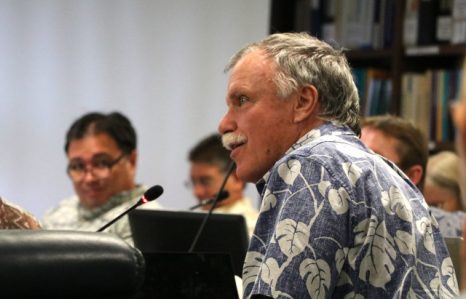
Fight Over Papahanaumokuakea Expansion Isn’t Over
Hawaii’s commercial fishing industry leaders are not finished fighting the fourfold expansion of a U.S. marine monument in the Northwestern Hawaiian Islands. Now the Western Pacific Regional Fishery Management Council, which actively opposed the expansion, wants the government to study the potential effects and find ways to alleviate them. “The impacts to the Hawaii fishing and seafood industries and indigenous communities as a result of monument expansion are considerable,” Council Chair Edwin Ebisui Jr. said in a statement Friday. “The Council will write to the President about these and request the Department of Commerce to mitigate them.” The latest wave of opposition to the monument rolled in earlier this month at the council’s Scientific and Statistical Committee meeting in Honolulu. New committee member Ray Hilborn, a prominent marine biologist from the University of Washington, railed against large marine protected areas. Read the story here 08:59
Atlantic States Marine Fishery Commission will decide status Gulf of Maine shrimp fishery
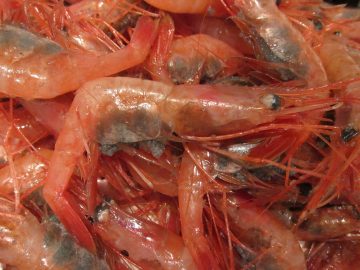 The commission is scheduled to meet Nov. 10 in Portsmouth, New Hampshire, first to review the most recent stock status report for northern shrimp and technical recommendations from the shrimp advisory panel. It will then set the specifications for the upcoming season. The stock status reports dating back to 2012 reveal a species in free fall, with record low levels of abundance and biomass and poor recruitment since 2012. Those assessments showed problems with overfishing, warming water temperatures and a dwindling number of spawning females. Maine harvesters dominated the fishery the last time it was open in 2013. Of the 207 vessels permitted to shrimp in the Gulf of Maine, 180 had hailing ports in Maine, while Massachusetts and New Hampshire each had 13. Read the story here 07:45
The commission is scheduled to meet Nov. 10 in Portsmouth, New Hampshire, first to review the most recent stock status report for northern shrimp and technical recommendations from the shrimp advisory panel. It will then set the specifications for the upcoming season. The stock status reports dating back to 2012 reveal a species in free fall, with record low levels of abundance and biomass and poor recruitment since 2012. Those assessments showed problems with overfishing, warming water temperatures and a dwindling number of spawning females. Maine harvesters dominated the fishery the last time it was open in 2013. Of the 207 vessels permitted to shrimp in the Gulf of Maine, 180 had hailing ports in Maine, while Massachusetts and New Hampshire each had 13. Read the story here 07:45



































